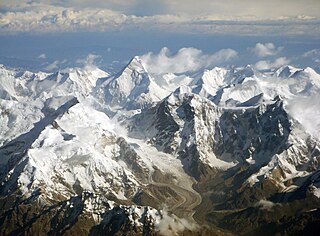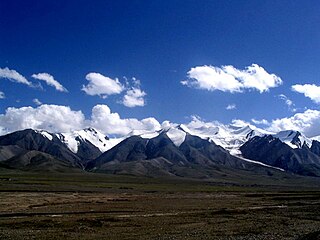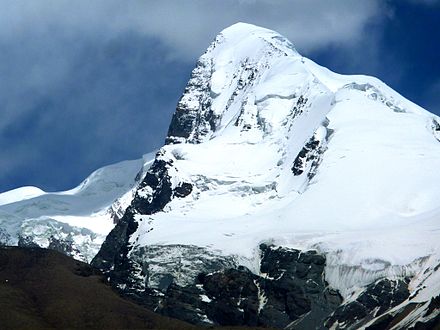
East Turkestan, also known as Uyghuristan, is a term with multiple meanings depending on context and usage. Historically, the term was invented by Russian Turkologists like Nikita Bichurin in the 19th century as a more neutral term to replace another Western term, Chinese Turkestan, which referred to the Tarim Basin in the southwestern part of Xinjiang Province of the Qing dynasty. The medieval Persian toponym "Turkestan" and its derivatives were not used by the local population of the greater region and China had its own name for an overlapping area since the Han dynasty as the Western Regions, with the parts controlled by China termed Xinjiang from the 18th century onward. The historical Uyghur name for the Tarim Basin is Altishahr, which means "Six Cities" in Uyghur.

The Tian Shan, also known as the Tengri Tagh or Tengir-Too, meaning the Mountains of Heaven or the Heavenly Mountain, is a large system of mountain ranges located in Central Asia. The highest peak in the Tian Shan is Jengish Chokusu, at 7,439 metres (24,406 ft) high. Its lowest point is the Turpan Depression, which is 154 m (505 ft) below sea level.

The Pamir Mountains are a mountain range in Central Asia, at the junction of the Himalayas with the Tian Shan, Karakoram, Kunlun, Hindu Kush, Suleman and Hindu Raj ranges. They are among the world's highest mountains.

The Kunlun Mountains constitute one of the longest mountain chains in Asia, extending for more than 3,000 kilometres (1,900 mi). In the broadest sense, the chain forms the northern edge of the Tibetan Plateau south of the Tarim Basin.

The Tarim River, known in Sanskrit as the Śītā, is an endorheic river in Xinjiang, China. It is the principal river of the Tarim Basin, a desert region of Central Asia between the Tian Shan and Kunlun Mountains. The river historically terminated at Lop Nur, but today reaches no further than Taitema Lake before drying out.

The Tarim Basin is an endorheic basin in northwest China occupying an area of about 1,020,000 km2 (390,000 sq mi). Located in China's Xinjiang region, it is sometimes used synonymously to refer the southern half of the province, or Nanjiang, as opposed to the northern half of the province known as Dzungaria or Beijiang. Its northern boundary is the Tian Shan mountain range and its southern boundary is the Kunlun Mountains on the edge of the Tibetan Plateau. The Taklamakan Desert dominates much of the basin. The historical Uyghur name for the Tarim Basin is Altishahr, which means "six cities" in Uyghur.
The Karakoram Highway is a 1,300-kilometre (810 mi) national highway which extends from Hasan Abdal in the Punjab province of Pakistan to the Khunjerab Pass in Gilgit-Baltistan, where it crosses into China and becomes China National Highway 314. The highway connects the Pakistani provinces of Punjab and Khyber Pakhtunkhwa plus Gilgit-Baltistan with China's Xinjiang Uyghur Autonomous Region. The highway is a popular tourist attraction and is one of the highest paved roads in the world, passing through the Karakoram mountain range, at 36°51′00″N75°25′40″E at maximum elevation of 4,714 metres (15,466 ft) near Khunjerab pass. Due to its high elevation and the difficult conditions in which it was constructed, it is often referred to as the Eighth Wonder of the World. The highway is also a part of the Asian Highway AH4.

Kongur Tagh or Kongkoerh is at 7,649 m the highest mountain wholly within the Xinjiang Uyghur Autonomous Region, China.

Taxkorgan Tajik Autonomous County is a county of Kashgar Prefecture in Western Xinjiang, China. The county seat is the town of Tashkurgan.

The Karakul or Karakuli is a lake located 196 km southwest of Kashgar, Xinjiang Uyghur Autonomous Region of China. It is located in Akto County, Kizilsu Kirgiz Autonomous Prefecture on the Karakoram Highway, before reaching Tashkurgan, the Khunjerab Pass on the China - Pakistan border and Sost in Pakistan.

Altyn-Tagh, is a mountain range in northwestern China that separates the eastern Tarim Basin from the Tibetan Plateau. The western third is in Xinjiang while the eastern part forms the border between Qinghai to the south and Xinjiang and Gansu to the north.

Muztagh Ata, or Muztagata, is the second highest of the mountains which form the northern edge of the Tibetan Plateau. It is sometimes regarded as being part of the Kunlun Mountains, although physically it is more closely connected to the Pamirs. It is also one of the relatively easier 7,000 m peaks in the world to climb, due to its gentle western slope and the comparatively drier weather of Xinjiang, though a thorough acclimatization period and a very strong physical condition are crucial for success.

Upal is a town in Shufu County in western Xinjiang, China.

Akto County is a county in Xinjiang Uygur Autonomous Region, China. It is under the administration of the Kyrgyz autonomous prefecture of Kizilsu. The county has two towns, 11 townships, four state-owned farms and a plant nursery under its jurisdiction, the county seat is Akto Town. The county contains an area of 24,555 km2 (9,481 sq mi) and has a population of 231,756.

Chinese Tajiks or Mountain Tajiks in China, including Sarikolis (majority) and Wakhis (minority) in China, are an extension of the Pamiri ethnic group that lives in the Xinjiang Uyghur Autonomous Region in the People's Republic of China. They are one of the 56 ethnic groups officially recognized by the government of China.

Chakragil is a major mountain in Xinjiang, China. It is located about 100 kilometres (60 mi) southwest of Kashgar, about 60 kilometres (40 mi) due north of Muztagh Ata, and 37 kilometres (23 mi) northwest of Kongur Tagh. It is in the subrange known as the Kingata Shan, generally included in the "Eastern Pamirs" as it are separated by the major Yarkand River valley from the extreme northwest end of the Kunlun Mountains, near the Pamir Mountains. The Gez River flows just south of the mountain.
The Muzart River or Muzat River is a river in Aksu Prefecture of Xinjiang Uyghur Autonomous Region, People's Republic of China, a left tributary of the Tarim River. An early 20th-century source also gives an alternative name for this river, Shāh-Yār-Daryā. Shāh-Yār-Daryā (شاهیاردریا) is a Persian word meaning 'The King's aide River.'

Xinjiang, officially the Xinjiang Uygur Autonomous Region (XUAR), is an autonomous region of the People's Republic of China, located in the far northwest of the country. Being the largest province-level division of China and the 8th largest country subdivision in the world, Xinjiang spans over 1.6 million km2. The Aksai Chin region, administered by China mostly as part of Xinjiang's Hotan Prefecture, is claimed by India. Xinjiang borders the countries of Mongolia, Russia, Kazakhstan, Kyrgyzstan, Tajikistan, Afghanistan, Pakistan (Gilgit-Baltistan) and India. The rugged Karakoram, Kunlun and Tian Shan mountain ranges occupy much of Xinjiang's borders, as well as its western and southern regions. Xinjiang also borders the Tibet Autonomous Region and the provinces of Gansu and Qinghai. The most well-known route of the historical Silk Road ran through the territory from the east to its northwestern border.
The Borohoro Mountains is one of the major ranges of the Tian Shan mountain system. It is almost entirely located within in China's Xinjiang Uyghur Autonomous Region, with only a few westernmost peaks being in Kazakhstan.

Bulungkol Township is a township of Akto County in Xinjiang Uygur Autonomous Region, China. Located in the middle west of the county, the township covers an area of 4,585 square kilometers with a population of 7,133. It has 5 administrative villages under its jurisdiction. Its seat is at Bulungkol Village (布伦口村).
















